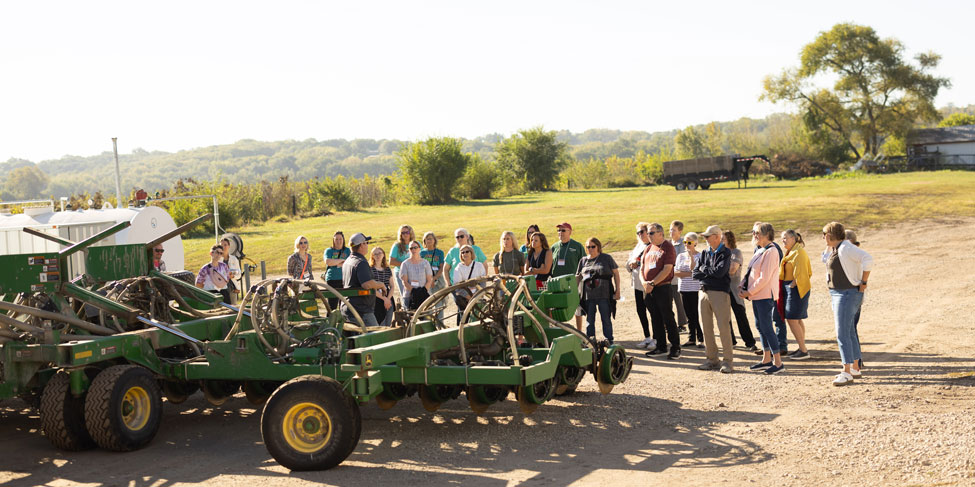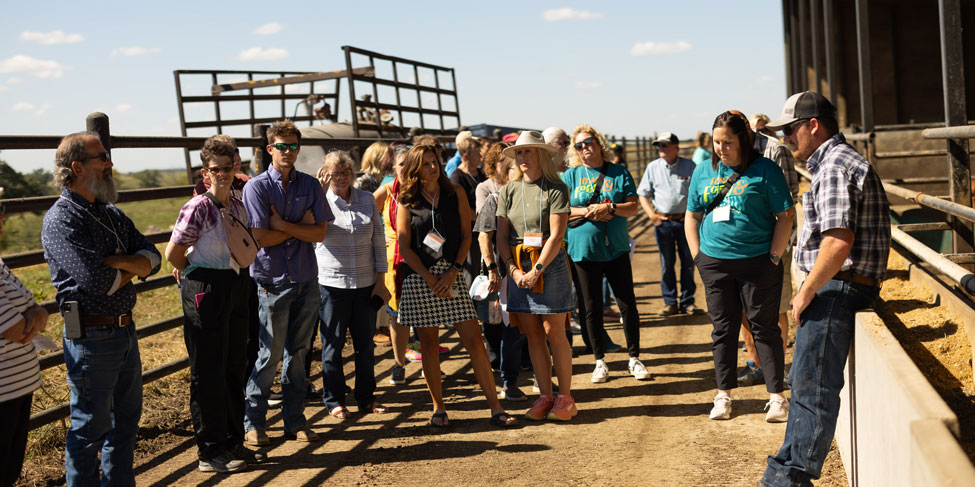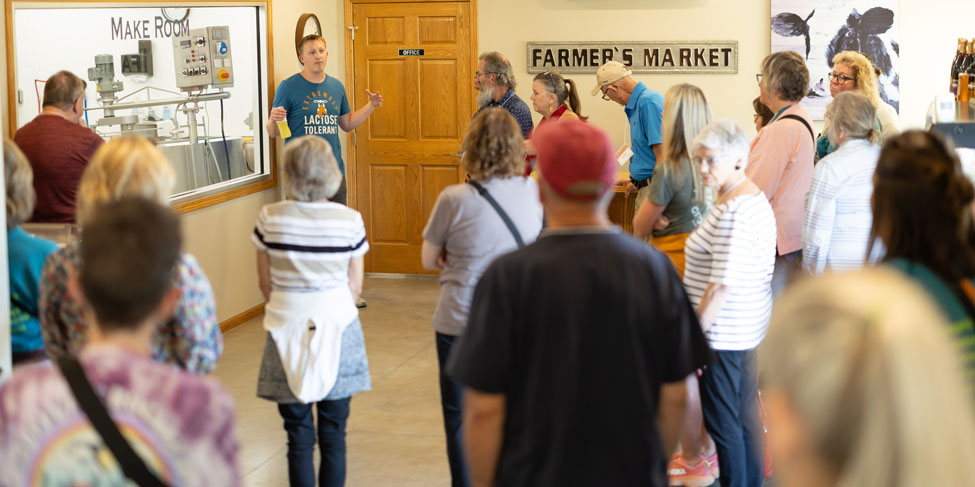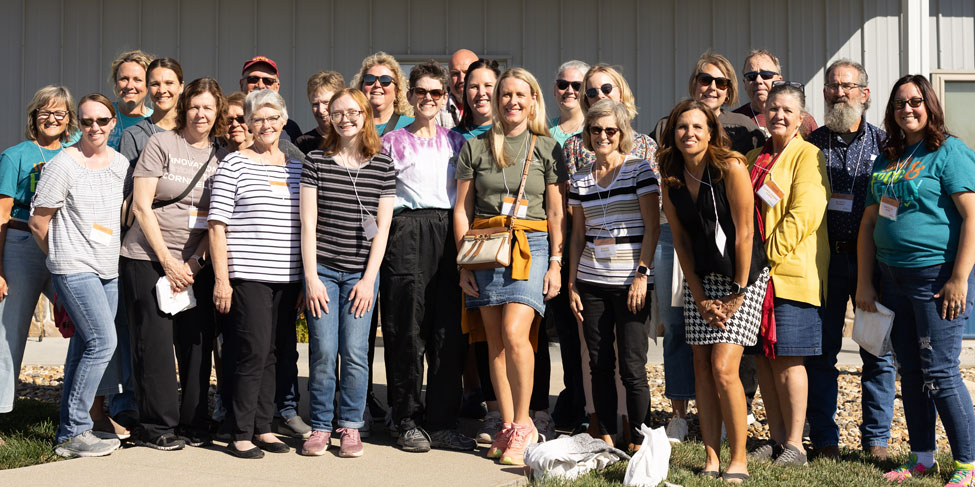From Iowa Farms to Dinner Tables Worldwide
October 29, 2024
By Gretchen Westdal Centers
On a sunny, deceptively brisk fall morning, a group of everyday Iowans met at the Iowa Soybean Association to embark on an all-day tour of three very different but very important farms throughout south central Iowa. With backgrounds ranging from city folk to country born to somewhere in between, these individuals came with shared and open minds to learn more about where their food comes from and how it makes its way into homes.
The Iowa Food & Family Project conducts Food U Tours throughout the year. The typically daylong event takes participants across the state to interact with and experience different industries that either rely on the state’s agriculture production or have a direct hand in producing agriculture. Past visits include farms, processing facilities, restaurants and more. The goal is to expand public perception and understanding of how food goes from Iowa farms to your table.
The September event focused on different farming operations starting in Carlisle, with a midway point in Albia, and ending in Leighton.
 Variety is Key at Sandridge Farms
Variety is Key at Sandridge Farms
Down a gravel road, just outside the capital city, lies Sandridge Farm. The operation is dotted with multiple outbuildings and barns, behemoth tractors and combines, a woodworking shop, fruit trees, hen pens and relic equipment of time gone by. Much like the proximity to the bustling Des Moines metro, Sandridge Farm balances modernism with tradition as it operates its farm. Cory Goodhue is a fourth-generation farmer and, along with his brothers, runs Sandridge Farms. It served as the first fall Food U Tour stop on the bright, bluebird September morning.
Sandridge Farm is a diversified operation that produces soybeans, corn, peas, grapes, trees and cover crops. Food U participants learned about the various ways Sandridge Farm is managing all their production. They have implemented new technology to introduce regenerative practices that include cover crops. Using drone technology, their pilot flies a drone outfitted with cover crop seeds to maximize their field use.
“It surprised me how technical and scientific farming is,” one of the Food U attendees notes in the post-tour survey. “There are many soil and weather conditions that farmers have to consider, and it's interesting to see the technology they use to track them all.”
 Henderson Cattle Farm Is a Family Affair
Henderson Cattle Farm Is a Family Affair
Following Sandridge Farms, the food tour continued to Henderson Cattle Farm outside Albia. The Henderson Family homestead, right near where the farm still operates today, was built in 1866 by Scottish-Irish immigrants John and Isabella Henderson. Rolling hills spotted with timber serve as the backdrop to this picturesque land that attracted the hearty Henderson family long ago. Today, Bob — John and Isabella’s great, great grandson — his wife, Patty, and their three sons, Aaron, Andy and Adam, all run the farm together.
Working full-time and in their specific roles, they take care of 500 cows, reproductive stock, a 1,200-head feed yard and a 1,700-acre row crop operation. Cattle are born and raised on grass, allowing heifers and calves to bond and feed. They continue to graze and commune together in pasture until moving closer to the farm when necessary.
The farm focuses on sustainability, conservation and carefully managing herd health through rotational grazing and reproduction. The farm grows 80–90 percent of the feed for the cattle, with the remaining coming from renewable energy by-products. They have been reducing commercial fertilizers and chemicals and implementing practices to increase soil quality and prevent erosion.
A tour attendee noted, “I eat a lot of meat daily but rarely consider the work that goes into raising the meat. Learning about cattle farming helped me understand more about where beef comes from and all the ways farmers work to create humane and sustainable conditions for their animals.”
 Frisian Farms Does Farm-Fresh Cheese
Frisian Farms Does Farm-Fresh Cheese
Iowa’s Dutch roots run deep. From Pella to Orange City, for many Iowans, parts of Dutch culture are commonplace in everyday lives. A great example of this can be found at Frisian Farms located in Leighton, where the Food U tour rounded out their day. The stop was a reminder of the agricultural ecosystem that enables a commodity to produce food for the public to enjoy. Frisian Farms sources their milk from local, small-scale dairy farmers nearby to make cheeses. This proximity to the milk helps ensure that their one-of-a-kind products use only the ingredients they know and trust.
Influenced by their Dutch heritage and growing up on a dairy farm, brothers Jason and Mike Bandstra decided to start making Gouda using the proper Dutch methods. It’s a complex, nearly scientific process that begins in the early morning and ends with flipping the handmade cheese rounds every 12 hours for the next four days until they are ready to age.
Food U participants got to hear firsthand about the process's intricacies and learn how the family finishes their product for the public to purchase in their storefront. The gouda made by Frisian Farms comes in various flavors, ranging from classic Gouda to the bacon flavor. They have 1,000 wheels of Gouda aging, just ready to be made into the next fan-favorite flavor.
 A New Connection to Food and Farming
A New Connection to Food and Farming
There’s a big difference between living in Iowa, driving by the miles of corn, soybeans and livestock with a vague appreciation for it, and hearing about a farmer talk about their livelihood while standing amongst it all with them. That’s what the Food U tour does for people. It gives them a front-row experience to a way of life that sustains us all. The tour scratches the surface of the vast amount of agriculture Iowa produces, but it is still a way for people outside of the industry to glean more insight into farming, food and the families who help create it.
Hear from a few participants on their takeaways from the day.
“Each Farmer, no matter the area of expertise, cares for the land and animals. Each one wants their specialty to be better than before and preserve it for the future.”
"The farms we visited are committed to excellence. The amount of planning and coordination work required to farm today is staggering. Even so, they are all concerned about conservation and our environment. Thank you, farmers!”
“The farmers we spoke with realize the value in their land and are using the most recent practices to retain that value, from cover crops to regenerative crops, to using the byproducts of cheese making as fertilizer.”
“Iowa Agriculture is alive and thriving! You don’t have to go far from home to experience the vast array of agricultural opportunities our state offers!”